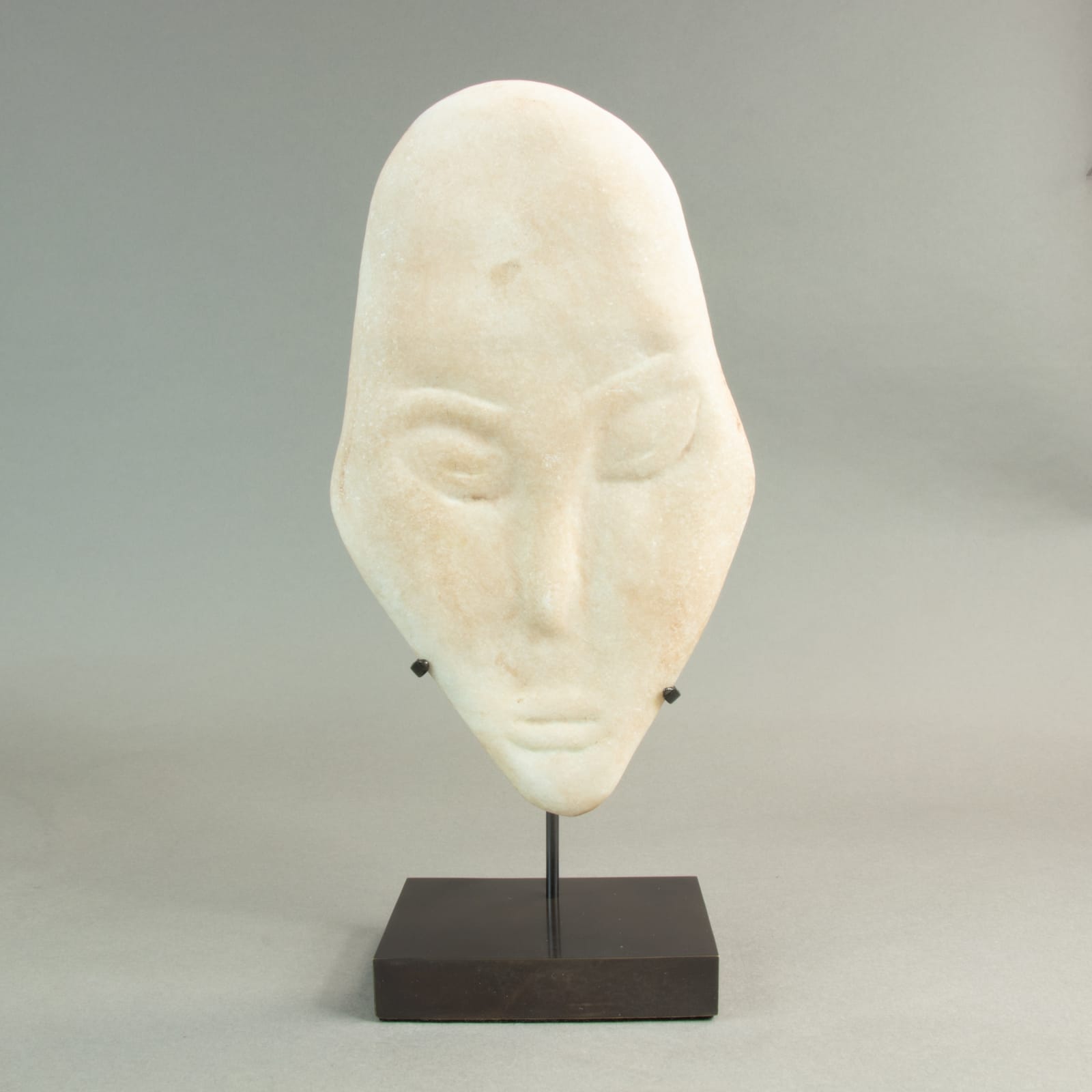Neolithic Marble Sculpture of a Face, 4000 to 3000 BCE
Marble
height 25 cm
height 9 7/8 in
Dimensions provided without mounting.
height 9 7/8 in
Dimensions provided without mounting.
ES.9903
This is an outstanding artwork dating back to the Neolithic period, originally found in the Sahara desert. The Neolithic period was a time of enormous change, of transitions from a...
This is an outstanding artwork dating back to the Neolithic period, originally found in the Sahara desert. The Neolithic period was a time of enormous change, of transitions from a highly mobile foraging existence to one of sedentary agriculture, accompanied by social and biological changes as the nature of society itself was transformed. The earliest manifestations of this are to be found in the Near and Middle East, where tiny villages in fertile areas grew and grew as the new ways of life began to take effect. From there, the social and technological advancements of the new age spread across the Mediterranean and beyond.
Perhaps most dramatic, for our purposes, were the magico-religious transformations. Humanity did not always make sculpture, but when they started to do so, one of the first things they made were representation of humans, a great testament to the introspective vocation of our species. Interpreting the significance of art at such a remove from ourselves is of course problematic, but the elongation of features seems of particular interest. The face is rendered in a rhomboidal shape, with the ears gently crafted through delicate protuberances at the cheeks, breaking the linearity of the face. The forehead is curved and its surface was gently smoothed out. The eyes are rendered as heavily lidded and almond shaped, with thick brows rendered with carvings. The line is represented as an elongated vertical ridge and distinguished from the cheeks by two large carvings, attentively smoothed out. The mouth is fleshy and rendered with a two individual carvings isolating the lower lip, and a gentle smoothed depression over the upper lip.
The elongation of facial features is a detail we find repeatedly throughout the Mediterranean and North Africa: specific groups of Cycladic figurines (roughly contemporary to this artefact) reveal this characteristic. Later on, the Egyptian pharaoh Akhenaten (reigning c. 1353–1336 BCE) will be distinguished iconographically by the elongation of his face.
The reasons behind the choice to render human features in an elongated fashion are far from clear, but it seems that artists during the Neolithic period when not particularly concerned about the naturalistic fidelity of their representation, but rather privileged the magic-ritual meaning and import of the artefacts they realised.
Due to the extremely singular iconography of this artefact, it is possible that it might represent a testimony of contacts at the dawn of civilisations between humans and visitors from other worlds and that such contacts were the origin of the revolutionary transitions from a foraging existence to agriculture, transitions accompanied by social and biological changes that change the nature of society itself forever.
This is an exceptional piece of art, bearing witness to the most enigmatic and fascinating times at the dawn of civilisation, and befitting the most discerning collectors.
Perhaps most dramatic, for our purposes, were the magico-religious transformations. Humanity did not always make sculpture, but when they started to do so, one of the first things they made were representation of humans, a great testament to the introspective vocation of our species. Interpreting the significance of art at such a remove from ourselves is of course problematic, but the elongation of features seems of particular interest. The face is rendered in a rhomboidal shape, with the ears gently crafted through delicate protuberances at the cheeks, breaking the linearity of the face. The forehead is curved and its surface was gently smoothed out. The eyes are rendered as heavily lidded and almond shaped, with thick brows rendered with carvings. The line is represented as an elongated vertical ridge and distinguished from the cheeks by two large carvings, attentively smoothed out. The mouth is fleshy and rendered with a two individual carvings isolating the lower lip, and a gentle smoothed depression over the upper lip.
The elongation of facial features is a detail we find repeatedly throughout the Mediterranean and North Africa: specific groups of Cycladic figurines (roughly contemporary to this artefact) reveal this characteristic. Later on, the Egyptian pharaoh Akhenaten (reigning c. 1353–1336 BCE) will be distinguished iconographically by the elongation of his face.
The reasons behind the choice to render human features in an elongated fashion are far from clear, but it seems that artists during the Neolithic period when not particularly concerned about the naturalistic fidelity of their representation, but rather privileged the magic-ritual meaning and import of the artefacts they realised.
Due to the extremely singular iconography of this artefact, it is possible that it might represent a testimony of contacts at the dawn of civilisations between humans and visitors from other worlds and that such contacts were the origin of the revolutionary transitions from a foraging existence to agriculture, transitions accompanied by social and biological changes that change the nature of society itself forever.
This is an exceptional piece of art, bearing witness to the most enigmatic and fascinating times at the dawn of civilisation, and befitting the most discerning collectors.
